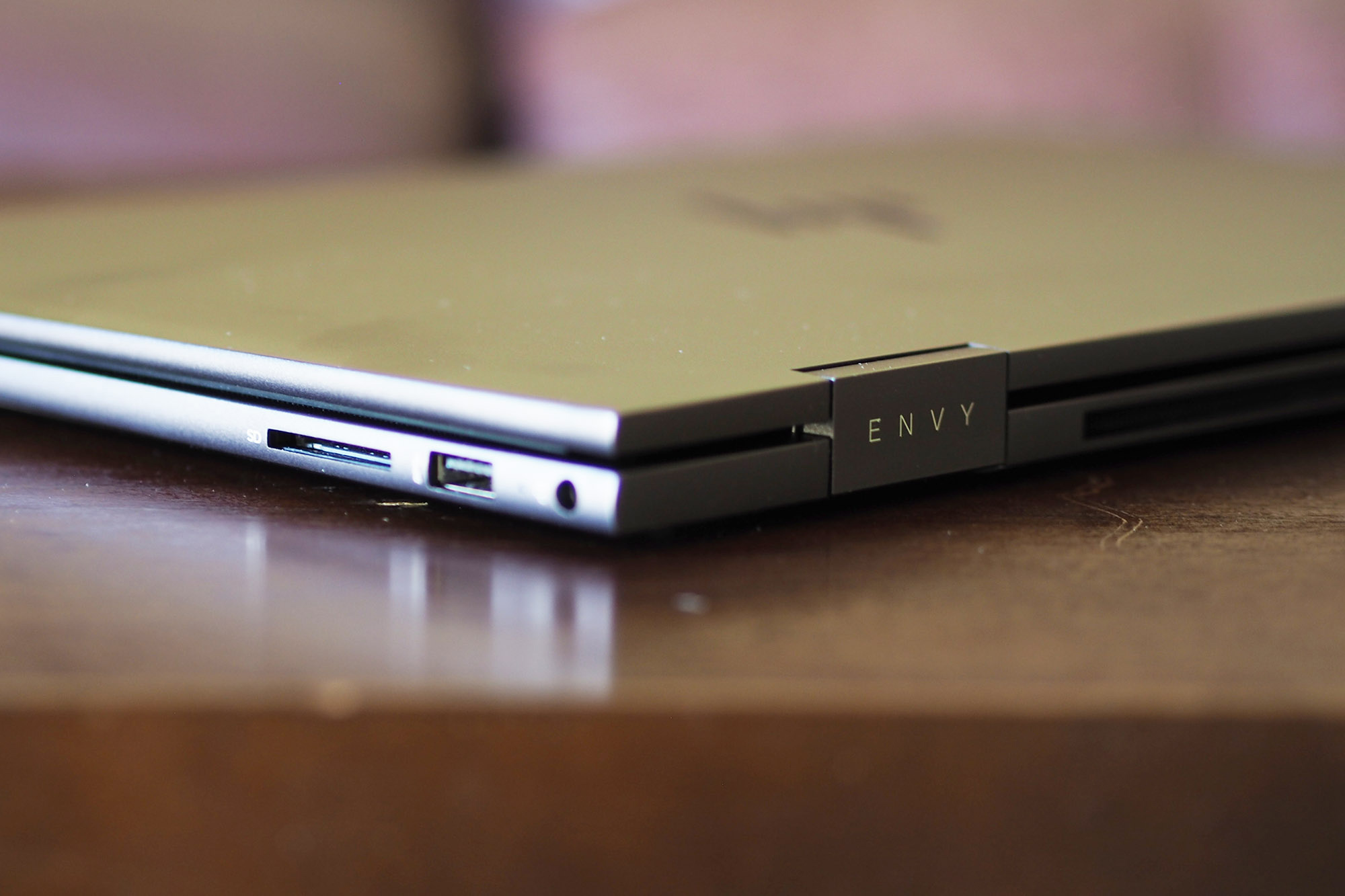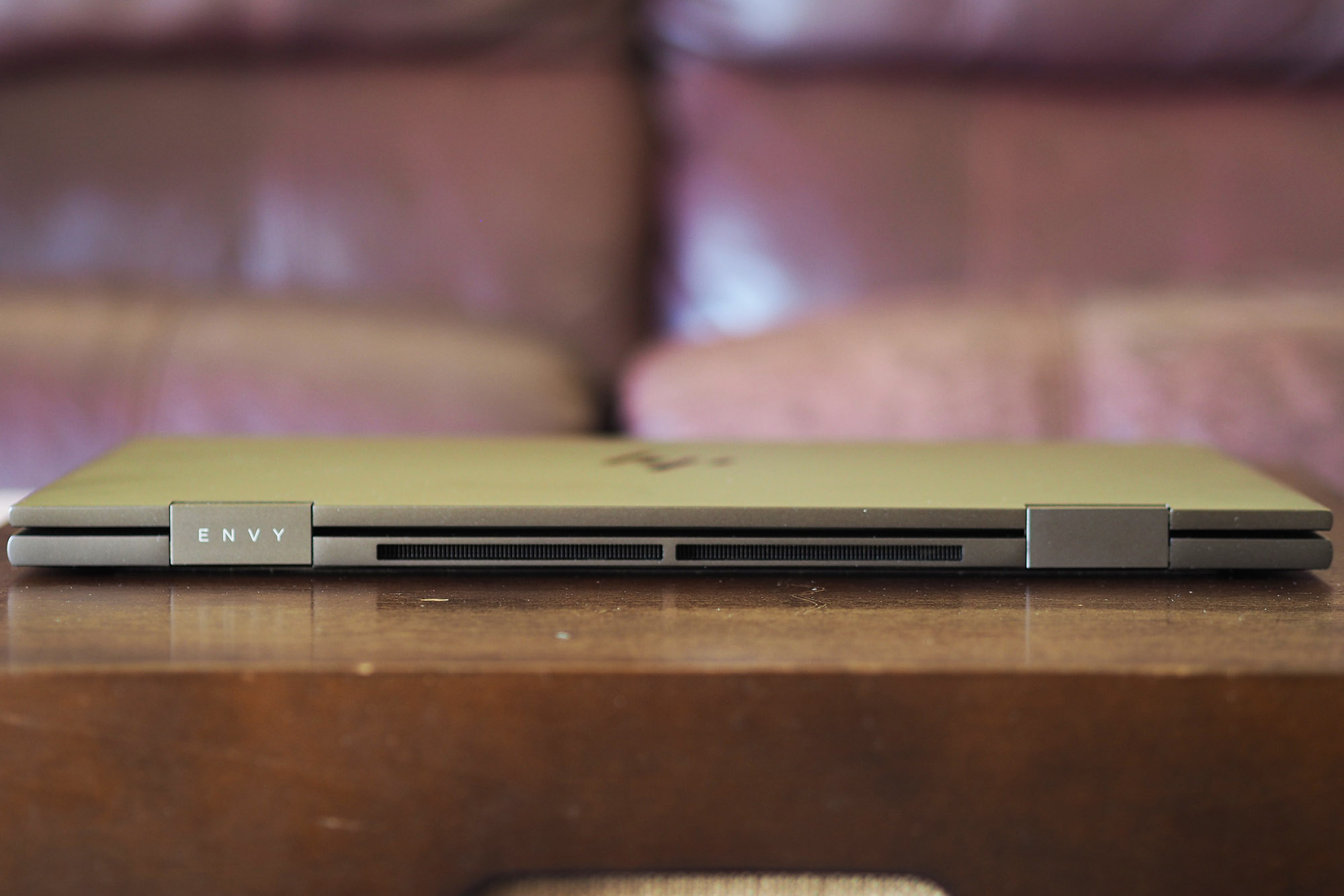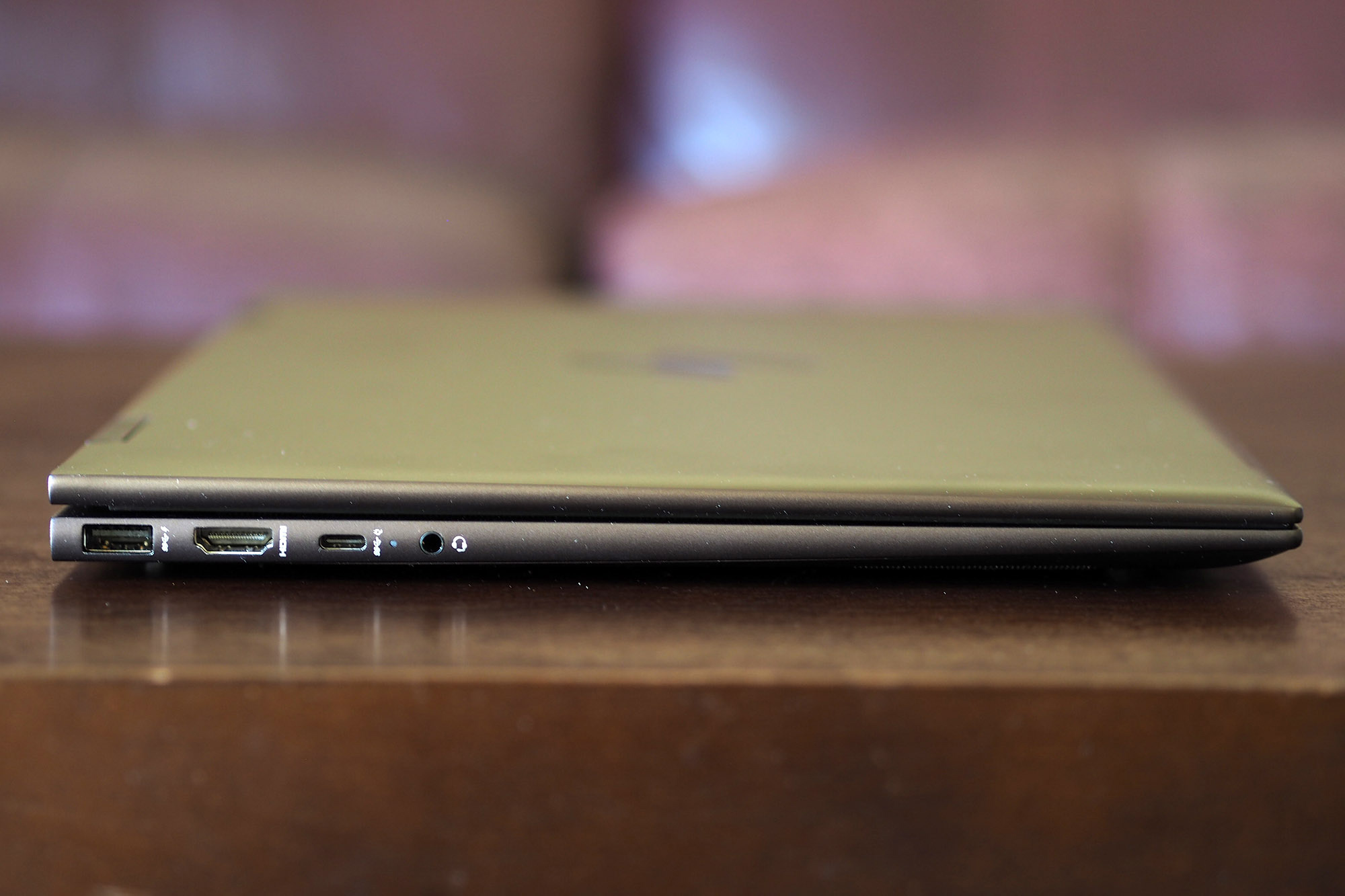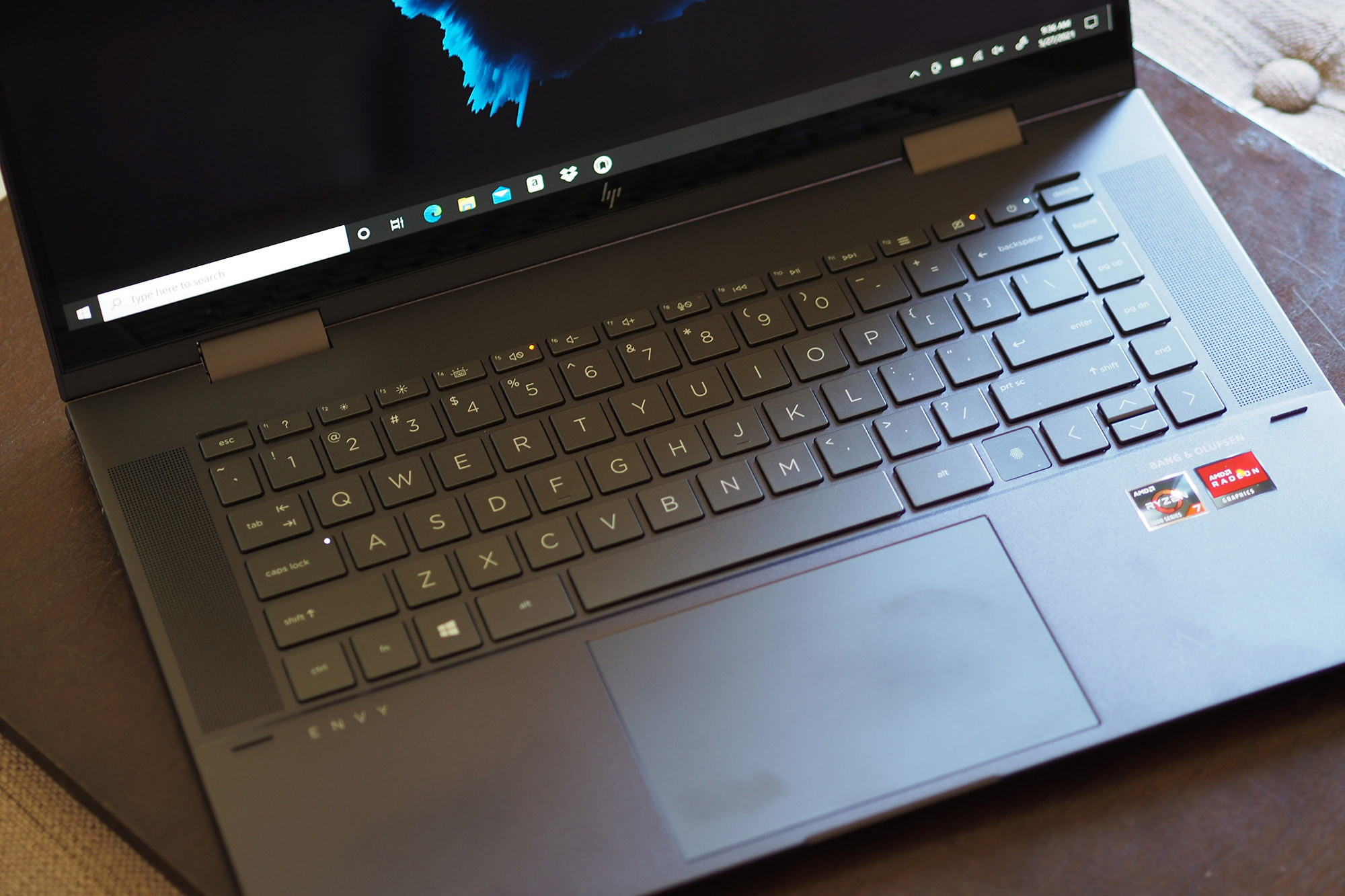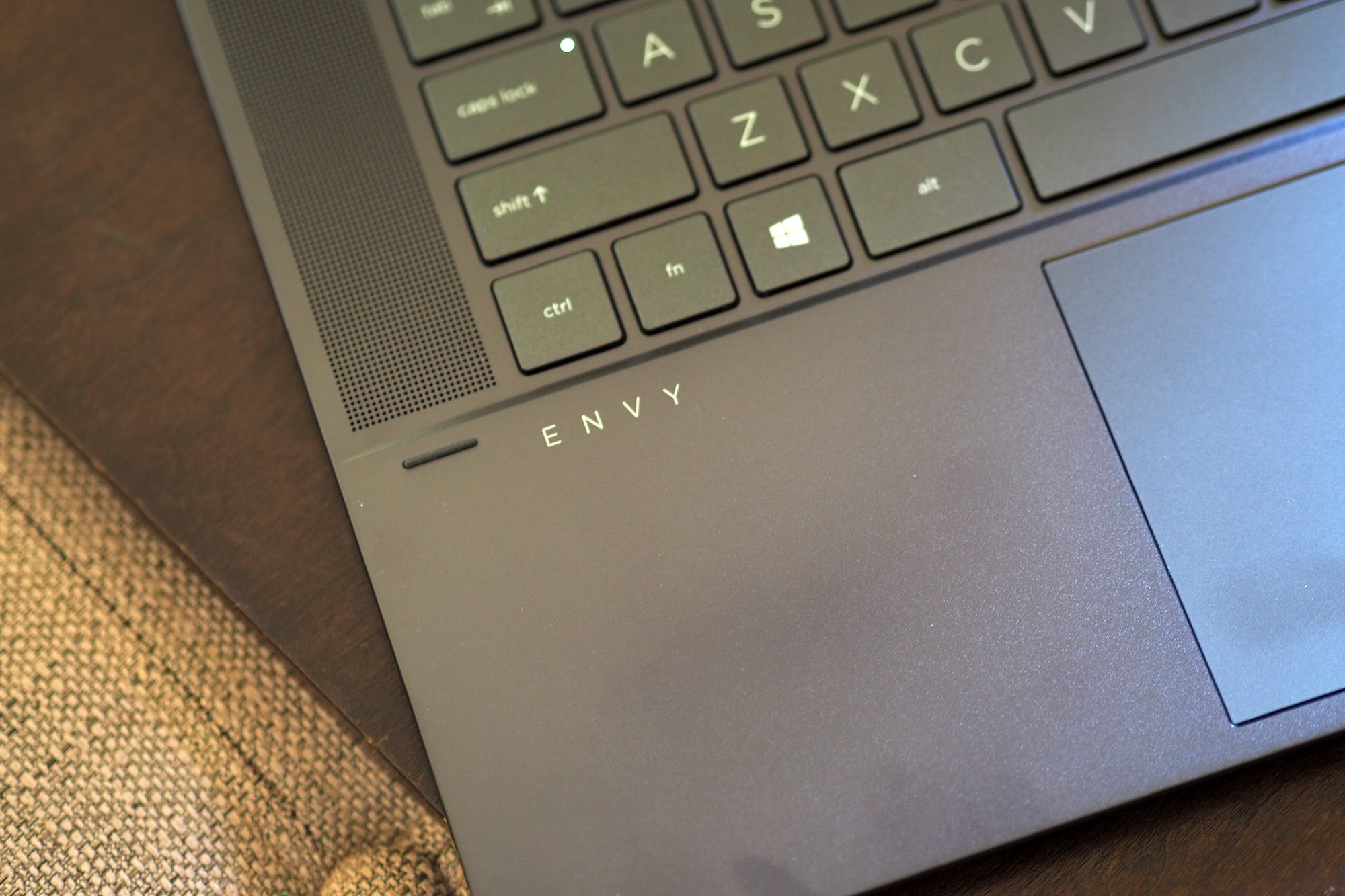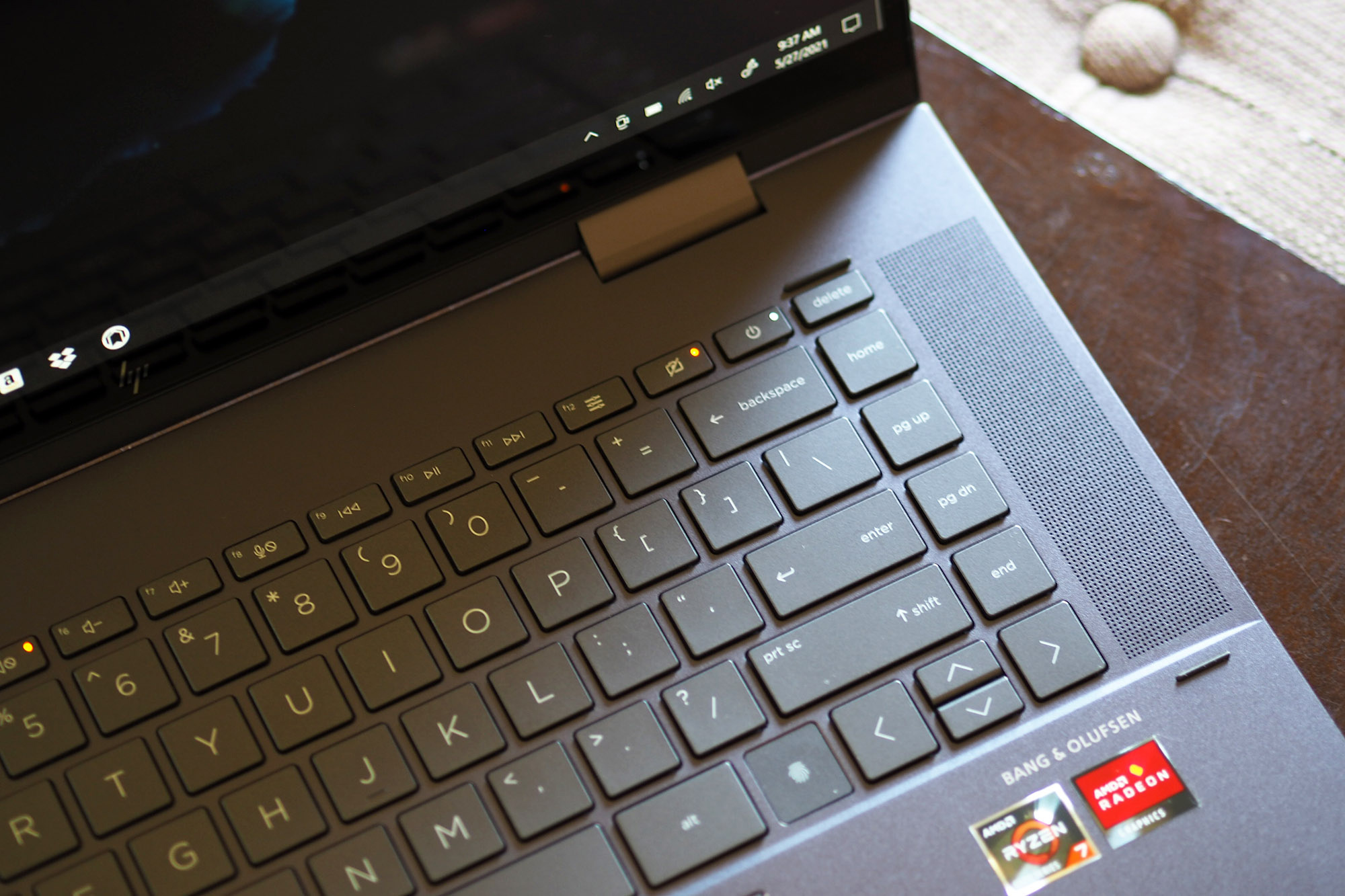“The HP Envy x360 15 with its AMD Ryzen 7 5700U is a high-powered 2-in-1 held back by a disappointing display.”
- Excellent productivity performance
- Solid build quality
- Conservative good looks
- Excellent keyboard and touchpad
- Affordable
- Poor performance in Adobe applications
- Battery life hampered by small battery capacity
- Display doesn't offer wide enough colors
Fast performance for content creation can get very expensive. That’s especially true on laptops.
HP’s Envy x360 15, powered by AMD Ryzen, is an antidote to that problem. The overall design has been tweaked, and HP now positions the 15-inch 2-in-1 — like other Envy machines, including the Envy 14 and the Envy 15 — as a machine made especially for creators.
I reviewed a $1,000 configuration equipped with the AMD Ryzen 7 5700U CPU, 16GB of RAM, a 512GB PCIe solid-state drive (SSD), and a 15.6-inch Full HD (1920 x 1080) display in the increasingly obsolete 16:9 aspect ratio. That’s an attractive price for a powerful laptop — on paper. Does the Envy x360 15 actually live up to its promise of being a creator’s dream machine?
Design

Like other recent Envy machines, the Envy x360 15 was designed with a minimalist aesthetic. Most likely, that’s to differentiate from HP’s Spectre line, which uses a gem-cut chassis and colored chrome edges to make a strong fashion statement. The Envy x360 15 is much simpler, with a uniform Nightfall Black color that, to my eyes, looks brown in certain lighting, rounded edges, and no other accents to any of the chamfered edges. The only splash of color is the gold HP logo on the lid. Like the Envy 14, Envy 15, and Lenovo’s Yoga line, it’s an attractive laptop that won’t announce itself in a crowd.
Also, like the rest of the Envy line, the Envy x360 15 is made of stamped aluminum, another distinguishing feature from the CNC machined aluminum used in the Spectres. Even so, the Envy x360 15 feels robust, with no bending in the lid and just a little keyboard flex. It’s not as solid as the Spectre x360 15 or, say, the Dell XPS 15, but it still feels like a premium laptop. The lid is rather stiff, requiring two hands to open, but it holds the display in place in clamshell, tent, media, and tablet modes.
In terms of its size, the Envy x360 15 benefits from an 88.7% screen-to-body ratio, meaning its bezels are reasonably small around all edges. The chin’s a little large, but that’s to be expected with a 360-degree convertible. It’s not quite as chiseled as the Spectre x360 15 with its 90% screen-to-body ratio, but it’s close enough.
It’s only slightly wider and taller than its more premium sibling, and it’s 0.72 inches thick and weighs 4.11 pounds — quite a bit thinner and lighter than the Spectre’s 0.76 inches and 4.81 pounds. Some of that weight difference is due to the battery capacity, where the Envy x360 15 has just 51 watt-hours compared to the Spectre’s 84 watt-hours. By comparison, the Dell XPS 15 is also 0.71 inches thick and weighs 4.5 pounds with its 97 watt-hour battery. The Envy x360 15 is a reasonably sized 15-inch 2-in-1, but it will still be cumbersome in tablet mode.
There’s plenty of connectivity, with a USB-A 3.1 port, full-size HDMI 2.0 port, USB-C 3.1 port, and audio jack along the left-hand side, and another USB-A 3.1 port and a full-size SD card reader along the right-hand side. Unfortunately, there’s no Thunderbolt 4 support given the AMD chipset, limiting flexibility and performance. Wireless connectivity is Wi-Fi 6 and Bluetooth 5.1 via an Intel AX 200 radio.
Performance

AMD’s latest Ryzen CPUs have been top performers in CPU-intensive tasks, and I was looking forward to putting the Ryzen 7 5700U through its paces. I expected solid CPU performance and GPU performance in line with Intel’s Iris Xe, and that’s pretty much what I got. Note that HP’s Command Center utility that offers different performance settings didn’t have much impact on the Envy x360 15 (as compared to the Spectre x360 14, which was much faster in “Performance” mode), and so I’m not mentioning those settings in this review.
Starting with Geekbench 5, the Envy x360 15 scored second-highest in the multi-core test among our comparison group in the table below. Only the MacBook Pro 13 with Apple’s M1 ARM CPU was faster, and none of the Intel-based
In the PCMark 10 Complete benchmark, the Envy x360 15 came in second again, this time behind the Asus ZenBook 13 OLED running a Ryzen 7 5800U. That’s thanks to a high score in the Content Creation portion of the test, where only Intel 45-watt H-series CPUs have scored better. The Ryzen 7 5700U beat out the entire field of U-series Tiger Lake
In our more real-world Handbrake test that converts a 420MB video to H.265, the Envy x360 15 was the fastest machine, even beating out the ZenBook 13 OLED with its faster Ryzen 7 chip. It was twice as fast as the HP Spectre x360 14 and almost 80 seconds faster than the Dell XPS 13. And in Cinebench 23, the Envy x360 15 was the fastest laptop we’ve tested, period — including H-series
The same can’t be said for the PugetBench benchmark that uses Premiere Pro to run through a series of demanding video editing tasks. Here, the Envy x360 15 managed a score of just 185. The Samsung Galaxy Book Pro 360 with a Core i7-1165G7 and Intel Iris Xe graphics scored 241, while the HP Envy 14 with a Core i5-1135G7 and Nvidia GeForce 1650 Ti Max-Q GPU scored a much higher 432.
Clearly, Intel and Adobe have worked together to optimize Premiere Pro for Intel chips, and the test absolutely benefits from a faster GPU. The latter is likely true for any application that can use the GPU to accelerate processes.
| Geekbench (single/multi) | Handbrake (seconds) | Cinbench R23 (single/multi) | PCMark 10 | 3DMark Time Spy | |
| HP Envy x360 15 (Ryzen 7 5700U) |
1198/6790 | 116 | 1258/8131 | 5419 | 1471 |
| Asus ZenBook 13 OLED (Ryzen 7 5800U |
1423/6758 | 124 | 1171 /7824 | 6034 | 1342 |
| Lenovo Yoga 9i (Core i7-10750H) |
1285/5551 | 144 | 1141/6400 | 5173 | 3487 |
| HP Spectre x360 14 (Core i7-1165G7) |
1214/ 4117 | 236 | 1389 /3941 | 4728 | 1457 |
| HP Envy 15 (Core i7-10750H) | 1274/5542 | 139 | N/A | N/A | 5123 |
| MacBook Pro 13 (M1) | 1707/7337 | N/A | 1487 /7547 | N/A | N/A |
| Dell XPS 13 (Core i7-1185G7) | 1549/5431 | 204 | 1399/ 4585 | N/A | 1380 |
The Ryzen CPUs are also limited in gaming thanks to integrated Radeon Graphics that are about as quick in the 3DMark Time Spy benchmark as Intel Iris Xe. I also ran Fortnite, where the Envy x360 15 managed 25 frames per second (fps) at 1080p and high graphics, and 16 fps with epic graphics selected. That’s within a few fps of Tiger Lake
Display

Along with performance, an excellent display with wide and accurate colors would be on any content creator’s wish list. The Envy x360 15, therefore, should offer up just that if it wants to target creative types.
Unfortunately, the 2-in-1’s IPS Full HD display — which I think is too low a resolution for 15-inch displays — falls short. It was the same with the Envy 14 (although that machine benefitted from a 16:10 aspect ratio), which in many other ways was an excellent creator’s workstation. Like that laptop, the Envy x360 15’s display suffered from colors that are plenty wide for premium productivity
The HP Envy 15 with its OLED display, another laptop that HP touts for creatives, hit 97% of AdobeRGB and 100% of sRGB, and Dell’s XPS 15 with its
The Envy x360 15’s display also wasn’t very bright, hitting just 270 nits and well under our preferred threshold of 300 nits. The Envy 15 managed 404 nits and the XPS 15 came in at 442 nits. Contrast also wasn’t a strength for the Envy x360 15, which hit 900:1 (under our premium threshold of 1,000:1), where the Envy 15’s OLED panel was at a ridiculous 404,410:1 and the XPS 15 was at 1480:1 (excellent for an IPS display).

The bottom line is that while the Envy x360 15’s display would be fine for productivity users, serious content creators will bemoan the lack of colors. I found the display to be fine for writing this review, albeit the brightness was still too low, but if I were doing any serious work in Photoshop or Premiere Pro, then I would have been disappointed.
The audio was plenty loud with no distortion, and mids and highs were pleasant. However, there was minimal bass, and although it looks like there are speakers on each side of the keyboard, there are just two downward-firing speakers. You’ll want
Keyboard and touchpad
The Envy x360 15 inherited the excellent keyboard from its Spectre siblings, offering up great spacing, large and attractive keycaps, and plenty of travel. The switches offer a nice bounce and a comfortable bottoming action, affording plenty of precision for fast typists. It’s my favorite keyboard behind Apple’s Magic Keyboard on the latest MacBooks. Only Dell’s XPS line comes close. One downside to the laptop’s design as that the power button is on the keyboard, meaning you have to open the lid to power it on.
The touchpad is 19% larger than the last version, taking up just about all the space available on the keyboard deck. That’s a welcome upgrade, and the Microsoft Precision touchpad was responsive and reliable with the full gamut of Windows 10 multitouch gestures. The touch display also supports MPP 2.0 pen protocol with 4,096 pressure sensitivity and tilt levels. A pen didn’t come bundled with my review unit, and so I didn’t get a chance to test it.
Windows 10 Hello support is provided by a fingerprint reader that’s embedded in the keyboard where the right control button normally goes. That’s a problem for any application that hard codes the right control button, but I found the reader to be fast and accurate.
Finally, you’ll find buttons on the keyboard to mute the microphone and physically shutter the webcam. Those are welcome privacy additions, and it’s easy to see when the webcam is covered thanks to an obvious pattern that’s visible even in poor lighting.
Battery life
HP only packed 51 watt-hours of battery life, which isn’t enough for such a powerful CPU and a large display (even if it is running at just Full HD). As mentioned earlier, the Spectre x360 15 enjoys 83 watt-hours of battery life and even the Spectre x360 14 has 67 watt-hours. I wasn’t expecting much in the way of longevity.
As it turns out, battery life was a mixed bag. In our web browsing test, which runs through a series of popular websites, the Envy x360 15 lasted for 11.25 hours, a solid score that’s slightly better than average. The Envy 14 was stronger at 12.6 hours, while the XPS 15
Switching to PCMark 10, I ran the Gaming test, and the Envy x360 15 died out after 1.5 hours, which is at the low end of the
All in all, the Envy x360 15 is a strong performer when it comes to productivity battery life. It will get you through a full day’s work and then some. It’s not as strong streaming media, and if you push the CPU and GPU, then you’ll want your power brick nearby. But overall, I was impressed that HP managed to squeeze decent battery life out of such a small battery — although one might add that if HP were to be a little less stingy, the Envy x360 15 could be a real world-beater in terms of longevity.
Our take
The Envy x360 15 is an attractive, well-built, and very powerful laptop for $1,000. With its 16GB of
Choose the Envy x360 15 as a fast (if you’re not worried about the GPU) 2-in-1 with a great keyboard, touchpad, and pen support for all your productivity needs. Just don’t expect too much if excellent colors are on your wish list.
Are there any alternatives?
The Spectre x360 15 is a better alternative if you’re looking to run Adobe apps. Its 45-watt CPU and discrete GPU win the day in this scenario. And you’ll want to choose the OLED display with its excellent colors if you’re a creative type. But it’s also quite a bit more expensive.
The Dell XPS 15 is the best clamshell alternative, with even better build quality, a vastly superior display, and better performance in Adobe apps. As with the Spectre, expect to pay quite a bit more.
Finally, you could choose the Envy 15, which again is more expensive but will provide excellent performance and another awesome OLED display. It’s not as fast in CPU-intensive apps, but its fast GPU will help it burn through processes that can take advantage of it.
How long will it last?
The Envy x360 15 is solidly built and sports modern components (except for the lack of
Should you buy it?
Yes. But as with the Envy 14, buy it for its productivity prowess, not if you need a lot of colors for your creative work.


